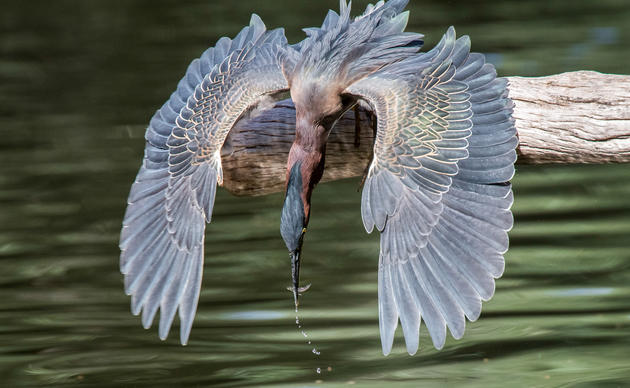This article first appeared on physicworlds.com on Apr 7, 2016.
Long-lived spin coherence in proteins found in the eyes of migratory birds could explain how the creatures are able to navigate along the Earth's magnetic field with extraordinary precision. This is the finding of researchers in the UK and Germany, who have created a new realistic model of cryptochrome proteins that is based on advanced simulations of nuclear and electron spins. The team also provides an explanation for how the avian magnetic compass has been optimized by evolution.
Every year, migratory birds navigate thousands of kilometres between their breeding and wintering grounds with remarkable accuracy. It has been known for a long time that this is, in part, due to their ability to detect the direction of the Earth's magnetic field, with research showing that some birds can detect the direction of field lines with an error of 5° or less. However, scientists do not have a good understanding of the biological mechanisms that make this magnetic sense possible.
Free radicals
One of the most popular theories is based on the idea that incoming photons excite light-sensitive proteins called cryptochromes in the retina of a bird's eye. This results in an electron being transferred between two molecules within the protein. The two resulting free-radical molecules each have an unpaired electron but, because they were produced simultaneously, the spins of the two electrons are correlated. The two electron spins form a coherent quantum state that is affected by weak external magnetic fields, such as the geomagnetic field. This interaction affects the chemical reactivity of the free-radical molecules and ultimately the signals that they send to the brain.
While this sounds plausible in theory, no one has explained exactly how this process allows the Earth's magnetic field to be measured to within 5° precision. Indeed, when people have calculated how the magnetically sensitive chemical reactions in the retina may respond to the direction of a weak magnetic field, they have found that "you can vary the direction of the field by many degrees without greatly changing the output signal," explains Peter Hore of the University of Oxford.
More nuclear spins
To address this shortcoming, Hore and colleagues at Oxford and the University of Oldenburg in Germany built a more realistic model of the molecules involved. Most previous research has modelled "simple radicals containing a single nuclear spin", but "the radicals in cryptochromes have many nuclear spins – 10 or 15 in each of the two radicals," Hore explains. "What we have done is to model something much more realistic, putting in many more nuclear spins, with realistic couplings to the electron spins." They also assumed that the spin coherences of the paired radicals are much longer lived than in previous models.
The team found that when the spin coherence times in its model were set to be longer than a few microseconds, there was a marked "spike" in the yield of the signalling state produced by spin-selective reactions of the radical pairs. As the spin lifetime is prolonged from 1 μs toward 100 μs, the spike emerges, strengthens and narrows. According to the researchers, such a feature could provide birds with directional information with sufficient precision to explain their navigational behaviour.
While the exact chemical signal produced in birds is unknown, Hore says that it is almost certainly a form of the cryptochrome protein that has a different shape. This difference in shape allows the protein to have different interactions with other proteins, and this starts the neural signalling process. The long-lived spin coherences provide enough time "for the interconversion of the singlet and triplet states of the radical pairs, and therefore the yield of the signalling state, to respond sensitively to the direction of the geomagnetic field", Hore explains. Radical pairs that do not go forward to the signalling state revert to the original protein structure.
Coherent evolution
Coherence is not expected to be long-lived in most biological systems, and the researchers suggest how birds could have evolved a molecular system that did not rapidly lose coherence. "The source of the spin relaxation that would destroy the coherence is the stochastic fluctuations of the radicals in their binding sites in the protein," explains Hore. If mutations in the proteins made those "motions both fast and of relatively low amplitude, then the loss of coherence should be inefficient, allowing the spin-correlated state to persist perhaps for 5–10 μm", which would be sufficient to produce the spikes in the yield of the signalling state, he adds.
Erik Gauger, from Heriot-Watt University in the UK, who was not involved in the research, says that it is a fascinating piece of work that brings "a level of detail and sophistication to the table that has been lacking in previous theoretical studies". He adds that it is a "significant step in the direction of finally beginning to unravel the inner workings of the avian compass".
Clear reason
"What is particularly exciting is that the [work] provides, for the first time, a clear reason why the compass might have evolved to support extraordinarily long spin-coherence times." Gauger told physicsworld.com. "About five years ago and based on a fairly generic model, we predicted that the spins should preserve quantum coherence on the order of 100 μs, to be consistent with the apparent extreme noise sensitivity of the compass. This timescale seemed very surprising at the time."
The study is described in Proceedings of the National Academy of Sciences.



